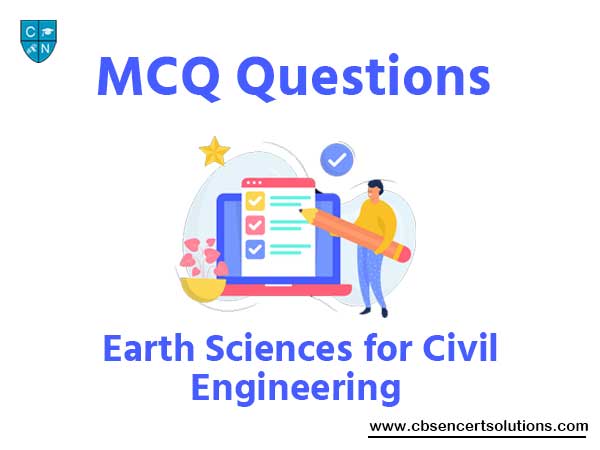Students should go through the Earth Sciences for Civil Engineering MCQ with Answers provided below. Earth Sciences for Civil Engineering is an important topic for various commerce and competitive examinations. It’s important to practice as many MCQ Questions with Answers for Earth Sciences for Civil Engineering as it will help them to practice and gain more expertise. Our team of expert faculty has designed questions with multiple-choice based on the latest examination pattern issued by various institutes. This will help them to gain understanding, have stronger concepts and get a better score in exams.
MCQ with Answers for Earth Sciences for Civil Engineering
Question. Which of the following is not depends on shear strength of the material?
(a) Cohesion
(b) Internal friction
(c) Normal stress
(d) Mass of the material
Answer
D
Question. Which one of the following is not an internal factor affects in slope processes?
(a) Lithology of the materials on the slope
(b) Ground water or rain water (run off)
(c) Geological Structures
(d) Earthquakes (Tectonic activity)
Answer
D
Question. New Zealand is an example of
(a) Convergent plate boundary
(b) Divergent plate boundary
(c) Conservative plate boundary
(d) Both convergent and conservative plate boundaries
Answer
D
Question. Along which active fault the Trans-Alaska pipeline was survived during an earthquake?
(a) Denali fault
(b) Himalayan frontal thrust
(c) Alpine fault
(d) None of these
Answer
A
Question. ________are defined as free falling fragments of rocks from steep cliff or slope.
(a) Rockfalls
(b) Toppling
(c) Debris avalanche
(d) Earthflow
Answer
A
Question. Subsidence results due to the constant or excess removal of ground water deplete the water table and increases the area of ____________.
(a) Water table
(b) Ground surface
(c) Zone of saturation
(d) Vadose zone
Answer
D
Question. ________ is the angle of a fault plane w.r.t. vertical.
(a) Hade
(b) Throw
(c) Heave
(d) Dip
Answer
A
Question. Terraces are remnants of former:
(a) Rivers
(b) Alluvial fans
(c) Floodplains
(d) None of these
Answer
C
Question. What type of drainage pattern would you expect to find where the main streams are parallel and very long and the edge of the folded sedimentary rock (weak and resistant) forms long parallel belts?
(a) Dendritic
(b) Rectangular
(c) Radial
(d) Trellised
Answer
D
Question. Surface along which the block of rock slip is called ?
(a) Fault zone
(b) Fault Plane
(c) Fault scarp
(d) None of these
Answer
B
Question. Now India is divided into ____________ seismic zones.
(a) 5
(b) 3
(c) 6
(d) 4
Answer
D
Question. 1995 Kobe earthquake was occurred in ________.
(a) Japan
(b) United States of America
(c) Taiwan
(d) India
Answer
A
Question. Which of the following is not categorised under geologic hazard?
(a) Tropical cyclone
(b) Earthquakes
(c) Volcano
(d) Floods
Answer
A
Question. Which one is the 2nd large magnitude earthquake occurred during past 100 yrs?
(a) 2001, Bhuj earthquake
(b) 2004, Sumatra earthquake
(c) 2015, Nepal earthquake
(d) 2005, Kashmir earthquake
Answer
B
Question. 2005 Muzaffarabad earthquake was occurred on _______ active fault.
(a) Kangra Active fault
(b) San Andreas fault
(c) Main Boundary thrust
(d) Tanda Active fault
Answer
D
Question. Sag pond is an example of :
(a) Normal fault
(b) Reverse fault
(c) Strike slip fault
(d) None of these
Answer
C
Question. The beds which have a gentle upstream dip will be_______ to the resultant force (R), hence can provides the best resistance to withstand the stresses or loads acting in the area.
(a) Parallel
(b) Perpendicular
(c) None of these
Answer
B
Question. Which one of the following is a secondary phenomenon during an earthquake?
(a) Fault scarp
(b) Terrace offset
(c) Liquefaction
(d) All of these
Answer
C
Question. Which of the following is not categorised under the Himalayan earthquake?
(a) Uttarkashi Earthquake
(b) Kangra Earthquake
(c) Gorkha Earthquake
(d) Bhuj Earthquake
Answer
D
Question. Taksal fault is an example of:
(a) Normal fault
(b) Reverse fault
(c) Strike slip fault
(d) None of these
Answer
C
Question. Which of the following is the suitable location for the construction of dams in a folded terrain?
(a) Crest of the fold
(b) Trough of the fold
(c) Limbs of the fold
(d) None of these
Answer
C
Question. The volume rate of flow of water at a point in a given time is:
(a) Competence
(b) Viscosity
(c) Discharge
(d) Capacity
Answer
C
Question. In which tectonic environment, you can find the surface expression in the form of folding?
(a) Extensional
(b) Compressional
(c) Strike slip
(d) All of these
Answer
B
Question. In which type of the fault the hanging wall is moving up with respect to foot wall?
(a) Normal fault
(b) Strike slip fault
(c) Reverse fault
(d) None of these
Answer
C
Question. From which of the following factor has not influence the drainage density:
(a) Climate
(b) Topography
(c) Soil infiltration capacity
(d) Anthropogenic activity
(e) Vegetation
(f) Geology
Answer
D
Question. Most suitable rocks for construction of tunneling:
(a) Argillaceous S.st
(b) Vesicular or amygdaloidal basalts
(c) Limestone
(d) Schist & Phyllite
Answer
B
Question. Tunneling _____________ to the fold axis is not at all desirable.
(a) Perpendicular
(b) Parallel
(c) None of these
Answer
A
Question. What is the rupture length of 2004 Sumatra-Andaman earthquake?
(a) 500 km
(b) 5000 km
(c) 1200 km
(d) None of these
Answer
C
Question. The San Andreas Fault is an example of:
(a) Normal fault
(b) Reverse fault
(c) Right lateral strike slip
(d) Left lateral strike slip
Answer
C
Question. Point on fault plane where slip initiated is termed as:
(a) Epicenter
(b) Hypocenter
(c) Fault scarp
(d) Hanging wall
Answer
B
Question. What is the subsidence occurred at Great Nicobar Island due to 2004 Sumatra-Andaman earthquake?
(a) 5 m
(b) 3 m
(c) 10 m
(d) None of these
Answer
B
Question. Which type of movement has been seen in right lateral strike-slip fault?
(a) Sinistral movement
(b) Dextral movement
(c) Upward movement
(d) None of these
Answer
B
Question. The displaced aqueduct of Al Harif is in between ________ and _________ plates.
(a) African plate and Arabian plate
(b) Indian plate and Eurasian plate
(c) African plate and Pacific plate
(d) None of these
Answer
A
Question. Abrupt uplift and gentle subsidence are indicative of:
(a) Hat microatoll
(b) Hemispherical coral head
(c) Cup microatoll
(d) Cylindrical coral head
Answer
C
Question. Driving force can be increased by:
(a) Decrease in amount of material on slope
(b) Increase in slope angle
(c) Decrease in slope angle
(d) None of these
Answer
B
Question. In translational slides, movement _______ to planes of weakness and occasionally _____to slope.
(a) Parallel, parallel
(b) Parallel, perpendicular
(c) Perpendicular, parallel
(d) Perpendicular, perpendicular
Answer
A
Question. Which of the following is not one of the channel pattern?
(a) Braided
(b) Narrow
(c) Meandering
(d) Straight
Answer
B
Question. Which of the following is not one of the three broad types of channel pattern?
(a) Straight
(b) Serrated
(c) Braided
(d) Meandering
Answer
B
Question. Tsunami waves are generated with the earthquake. True or false.
(a) False
(b) True
(c) None of these
Answer
B
Question. Which is the largest subduction earthquake?
(a) 1960 Chile earthquake
(b) 1905 Kangra earthquake
(c) 2011 Tohuku earthquake
(d) 2004 Sumatra-Andaman earthquake
Answer
A


